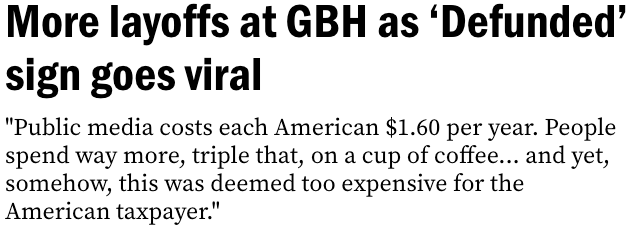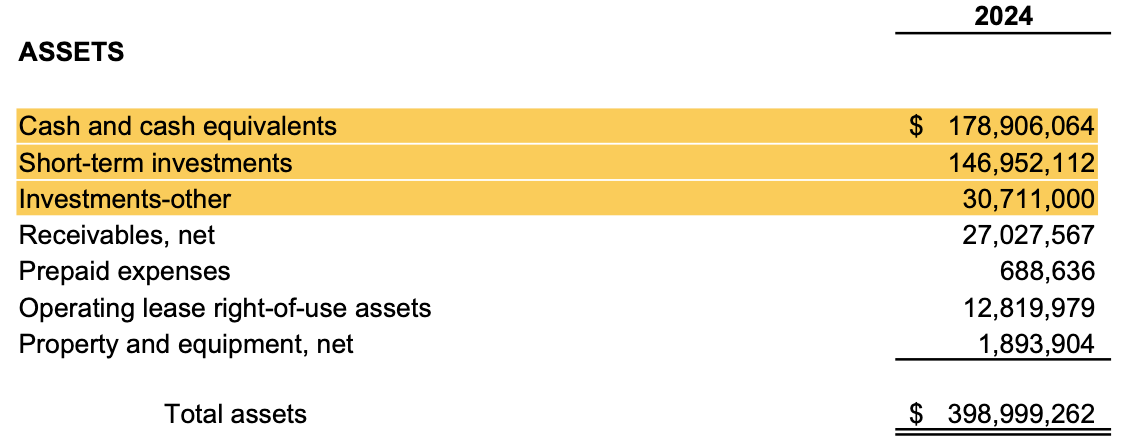Why Would Media Report on Public Broadcasting Funding and Ignore their Financial Records?
The legacy media gives public broadcasting a pass, so let's look at some numbers
The finances of public media have been plagued for years by lies of omission, and that’s continued in a big way with coverage of recent Congressional cuts.
Racket’s Matt Taibbi wrote a column a few months ago called “The Angst of the Well-Endowed,” about a major oversight in reporting on Johns Hopkins University’s layoffs off 2,000 workers. USAID budget cuts were blamed. Matt pointed out what legacy media omitted from their overly sympathetic stories on Johns Hopkins and other affluent schools that are supposedly suffering: they’re sitting on a shitload of cash, in the case of Johns Hopkins a $13.5 billion endowment! Columbia University’s is even bigger, with $3.7 billion in undesignated cash reserves.
At best, it’s lazy not to include this information and ask something like, I don’t know, “Why are you blaming the government when you have so much money?” At worst, something more sinister is at play.
Another lie of omission has been occurring in reports about layoffs in public media since Congress voted to claw back $1.1 billion in federal funding from the Corporation for Public Broadcasting, which disburses federal money to NPR, PBS, and their affiliates across the country. Several stations announced layoffs in response, with the media regurgitating “woe is us” talking points. Some headline examples:
One would think reporters would give their audience an idea of stations’ finances by doing something very simple: report on the money they have. There’s no excuse not to. The information is public record and especially easy to look up, thanks to ProPublica’s fantastic Nonprofit Explorer tool. It’s also on stations’ websites. I generally don’t support taxpayer funding — I never did in my 23 years in public media — but even if you do, supporters of public broadcasting and reporters should scrutinize stations’ finances.
It was more of the same on Friday, when CPB announced it will axe most staff by September 30th. From the Washington Post:
A small team will stay through January 2026 “to ensure a responsible and orderly closeout of operations. This team will focus on compliance, final distributions, and resolution of long-term financial obligations, including ensuring continuity for music rights and royalties that remain essential to the public media system.”
Again, you’d think that it would be a good idea to report how much money CPB still has and maybe address its specific plans. But nothing. Not from NPR, the New York Times, Washington Post, or the Associated Press.
It turns out that CPB had nearly $400 million in assets as of September 30th, according to its audit completed in February. That includes nearly $180 million in cash, and about the same amount in investments. The amount below includes $223 million in assets without donor restrictions, meaning there are no restrictions on how the money can be spent.
The audit also shows $175 million in liabilities, mostly for grants and contracts.
A CPB spokesperson said Tuesday that “numbers have changed” since the audit, but that “we are exploring the possibility” of giving stations another round of cash from the money it has left. Any disbursement must be made by September 30th.
NPR and WaPo, however, did provide this quote from buffoon NPR CEO Katherine Maher:
The ripple effects of this closure will be felt across every public media organization and, more importantly, in every community across the country that relies on public broadcasting.
Here are some financials on other organizations that were the subject of headlines above.
American Public Media
American Public Media, which oversees Minnesota Public Radio, is one of the giants in public media, with about 500 employees. It announced cutbacks of 5-8% on July 24, or about 25-40 employees. According to its most recent 990 form, a required IRS filing for nonprofits, it carries liabilities of $48 million, but also $178 million in assets, including $75.7 million without donor restrictions!
Seventy-five million is a lot more than what 40 employees cost. That amount would cover all 40 of those employees even if they were paid $725,000 a year, the compensation rate of APM’s president and CEO.
(W)GBH
“We needed to take some pretty quick action.” Those were the words of WGBH CEO and President Susan Goldberg in discussing layoffs of 13 people who work for the excellent documentary series “American Experience.” The Boston Globe points out that the legendary Boston public outlet GBH (formerly WGBH) has had two other rounds of layoffs since 2024.
An audit completed in November 2024 shows GBH has $375 million in liabilities, but $576 million in assets, and about 75% of that amount is without donor restrictions!
A story on Boston.com referenced a digital sign at GBH’s swanky headquarters that’s received a lot of attention:
Defunded, yes, but that doesn’t mean GBH and other stations don’t have money. Call me crazy, but pleading poverty all the time while sitting on resources isn’t exactly a sound strategy to build trust.
Update: This story has been updated to include CPB’s response to questions that were sent last Friday. CPB says “we are exploring the possibility” of giving additional funding to stations with the money it has left.









How will rural Americans survive without constant stories of how climate change disproportionately affects trans women of color?
It's so on-brand for these people to go down with facially disingenuous concern-trolling about "underserved rural communities." I happen to know how they talk about rural Americans behind closed doors.